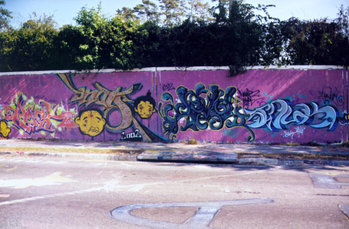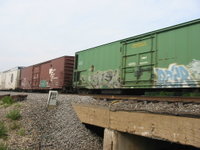About Graffiti
Graffiti is a type of deliberately illegal inscribed marking made by humans on surfaces, both private and public and may usually appear in bad neighborhoods. It can take the form of art, drawings or words. When done without a property owner's consent it often constitutes vandalism. Graffiti has existed at least since the days of ancient civilizations such as classical Greece and the Roman Empire.
History of graffiti
Historically, the term graffiti originally referred to the inscriptions, figure drawings, etc., found on the walls of ancient sepulchers or ruins, as in the Catacombs of Rome or at Pompeii. Usage of the word has evolved to include any decorations (inscribed on any surface) that one can regard as vandalism; or to cover pictures or writing placed on surfaces, usually external walls and sidewalks, without the permission of an owner. Thus, inscriptions made by the authors of a monument are not classed as graffiti.
Modern graffiti
In the 20th century, especially during World War II, 'Kilroy was here' became a famous graffito, along with Mr. Chad, a face with only the eyes and a nose hanging over the wall, saying "What No [scarce commodity]…?" during the time of rationing. Twentieth century warfare saw the advent of many new aviation technologies, closely followed by the advent of airplane graffiti, including the nose art made famous during World War II.
Graffiti Terminology
A number of words and phrases have come to describe different styles and aspects of graffiti. Like all slang and colloquialisms the phrases vary in different cities and countries.
Legal situation
Graffiti is subject to different societal pressures from popularly-recognized art forms, since graffiti appears on walls, freeways, buildings, trains or any accessible surfaces that are not owned by the person who applies the graffiti. This means that graffiti forms incorporate elements rarely seen elsewhere. Spray paint and broad permanent markers are commonly used, and the organizational structure of the art is sometimes influenced by the need to apply the art quickly before it is noticed by authorities.
Types Graffiti
Aerosol or "spray can" art
 The strand of graffiti art which is considered one of the four elements of hip hop culture is usually denoted urban 'Aerosol Art'. Sometimes synonymous with "hip-hop heads," so-called graffiti artists have gone beyond that stereotype and are abundant even among middle-class white children. Different genres exist, from Philadelphia's wicked style to California and New York's wild style graffiti. Graffiti artists are classified based on their style and sometimes even on what surface they use. The strand of graffiti art which is considered one of the four elements of hip hop culture is usually denoted urban 'Aerosol Art'. Sometimes synonymous with "hip-hop heads," so-called graffiti artists have gone beyond that stereotype and are abundant even among middle-class white children. Different genres exist, from Philadelphia's wicked style to California and New York's wild style graffiti. Graffiti artists are classified based on their style and sometimes even on what surface they use.
Bombing
"Bombing" in the graffiti world refers to the act of vandalising property with one's signature or logo. "Bombing"-type graffiti can manifest itself in many different forms, but always happens illegally.
Subway graffiti
A primary target for graffiti in urban environments are subway trains. This is especially true for New York City, where "going all city" is considered the holy grail. This phrase means to have your tag inside and outside on a train running each of the many lines of the NYC subway system.
Freight-train graffiti
 Freight cars and other railroad cars make another popular target for writers. The origins of train writing probably date back to the hobos of the early 20th century. Generally hobos while freighthopping would write their name or initials on the inside (or less frequently, the outside) of a boxcar to show they had been there, occasionally they would write other hobo symbols in chalk or grease pencil to indicate the train's destination and other routes. Freight cars and other railroad cars make another popular target for writers. The origins of train writing probably date back to the hobos of the early 20th century. Generally hobos while freighthopping would write their name or initials on the inside (or less frequently, the outside) of a boxcar to show they had been there, occasionally they would write other hobo symbols in chalk or grease pencil to indicate the train's destination and other routes.
Street art and Post-Graffiti
In the 1980s and early 1990s the writers Cost and Revs became the first to get up with their name with the new techniques that would become a new form of graffiti, i.e. Post-Graffiti (a term which comes from the French artist Stak), also known as Street Art.
Radical and political graffiti
Graffiti often has a reputation as part of a subculture that rebels against authority, although the considerations of the practitioners often diverge and can relate to a wide range of attitudes. Some see graffiti not only as an art but also as a lifestyle. It can express a political practice and can form just one tool in an array of resistance techniques.
Computer-generated graffiti
Since many people consider graffiti artists as vandals, many such artists have moved to creating computer generated graffiti instead, using computer graphics to mimic and expand on the styles of aerosol art.
Other graffiti forms
More forms of graffiti such as tree graffiti, bathroom graffiti, airplane graffiti, etc...
|

 The strand of graffiti art which is considered one of the four elements of hip hop culture is usually denoted urban 'Aerosol Art'. Sometimes synonymous with "hip-hop heads," so-called graffiti artists have gone beyond that stereotype and are abundant even among middle-class white children. Different genres exist, from Philadelphia's wicked style to California and New York's wild style graffiti. Graffiti artists are classified based on their style and sometimes even on what surface they use.
The strand of graffiti art which is considered one of the four elements of hip hop culture is usually denoted urban 'Aerosol Art'. Sometimes synonymous with "hip-hop heads," so-called graffiti artists have gone beyond that stereotype and are abundant even among middle-class white children. Different genres exist, from Philadelphia's wicked style to California and New York's wild style graffiti. Graffiti artists are classified based on their style and sometimes even on what surface they use.  Freight cars and other railroad cars make another popular target for writers. The origins of train writing probably date back to the hobos of the early 20th century. Generally hobos while freighthopping would write their name or initials on the inside (or less frequently, the outside) of a boxcar to show they had been there, occasionally they would write other hobo symbols in chalk or grease pencil to indicate the train's destination and other routes.
Freight cars and other railroad cars make another popular target for writers. The origins of train writing probably date back to the hobos of the early 20th century. Generally hobos while freighthopping would write their name or initials on the inside (or less frequently, the outside) of a boxcar to show they had been there, occasionally they would write other hobo symbols in chalk or grease pencil to indicate the train's destination and other routes.